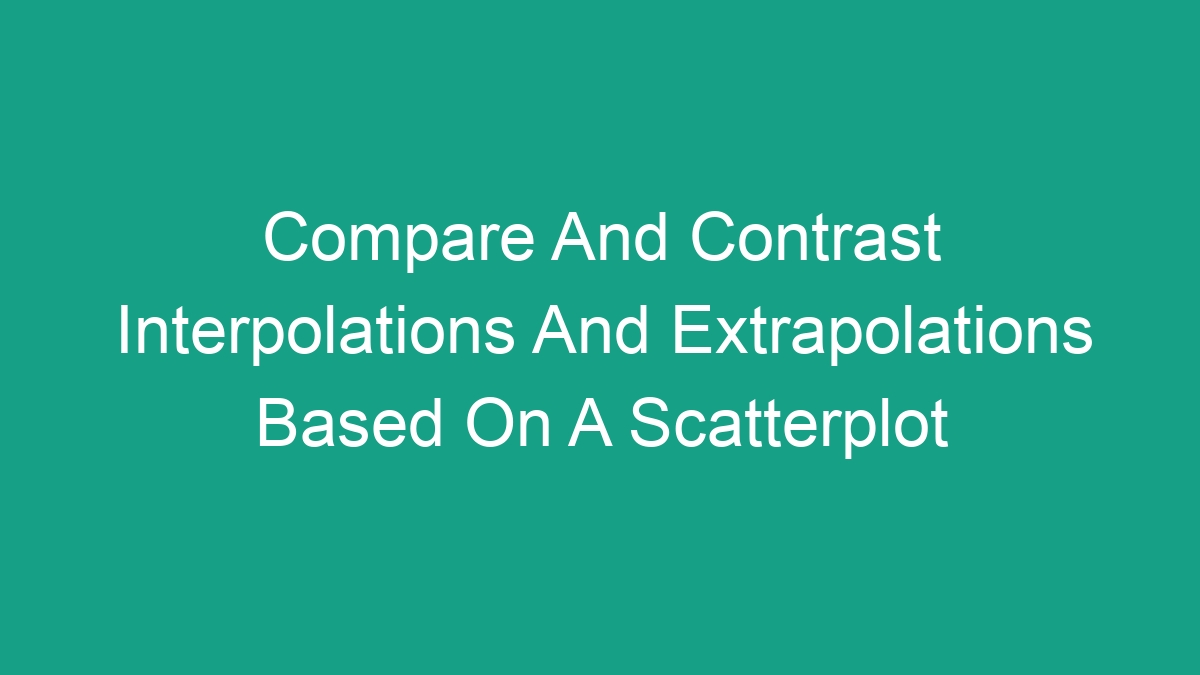
Understanding Interpolations and Extrapolations
Interpolations and extrapolations are two different methods used in data analysis to estimate values between known data points and to extend beyond the range of known data, respectively. When working with scatterplots, it is important to understand the differences between these two methods and how they can impact the interpretation of data.
Interpolation involves estimating values within the range of known data points. This method is used when there is a need to fill in the gaps between existing data points. In other words, it is used to estimate values for points that fall within the range of the data points that are available.
Extrapolation, on the other hand, is used to estimate values beyond the range of known data points. This method is employed when there is a need to predict or forecast values for points that fall outside the range of the existing data.
Use of Scatterplots in Data Analysis
Scatterplots are graphical representations of data points on a two-dimensional plane, with one variable on the x-axis and another variable on the y-axis. They are commonly used to assess the relationship between two variables and to identify patterns or trends within the data.
When working with scatterplots, it is essential to understand how interpolations and extrapolations can be used to estimate values and make predictions based on the data.
Comparing Interpolations and Extrapolations
When comparing interpolations and extrapolations, it is important to consider the potential implications of each method on the interpretation of the data.
Interpolations are often considered more reliable than extrapolations, as they are based on existing data points within the range of the known data. This means that the estimated values are derived from observed data, making them less prone to errors or uncertainties.
However, extrapolations can be useful when there is a need to make predictions or forecasts beyond the range of existing data. While extrapolations carry a higher degree of uncertainty, they can provide valuable insights into potential trends or patterns that may exist outside the known range of data.
Challenges and Considerations
When using interpolations and extrapolations based on a scatterplot, it is crucial to consider the limitations and potential challenges associated with each method.
Interpolations may be limited by the accuracy and reliability of the existing data points. If the data is sparse or exhibits high variability, the estimated values obtained through interpolation may not accurately represent the underlying relationship between the variables.
On the other hand, extrapolations are inherently more uncertain, as they involve extending the trends or patterns observed within the known data range to make predictions beyond that range. This can lead to significant inaccuracies if the underlying relationships between the variables change outside the range of the existing data.
Best Practices for Interpolations and Extrapolations
When utilizing interpolations and extrapolations based on a scatterplot, it is important to adhere to best practices to ensure the accuracy and reliability of the estimated values.
Data Quality: Ensure that the data used for interpolations and extrapolations is of high quality and accurately represents the variables being analyzed. Low-quality data can lead to inaccurate estimates and predictions.
Validation: Validate the estimated values obtained through interpolations and extrapolations against additional sources or methods to assess their accuracy and reliability.
Uncertainty Analysis: Conduct an uncertainty analysis to quantify and account for the potential errors or inaccuracies associated with interpolations and extrapolations. This can provide valuable insights into the reliability of the estimated values.
Applications of Interpolations and Extrapolations
Interpolations and extrapolations based on scatterplots have a wide range of applications across various fields, including finance, economics, environmental science, and engineering.
In finance, for example, interpolations and extrapolations can be used to estimate future stock prices based on historical data trends. In environmental science, these methods can be employed to predict the impact of climate change on ecosystems. In engineering, they can be used to forecast future trends in structural integrity based on observed data.
Conclusion
In conclusion, interpolations and extrapolations based on a scatterplot are valuable tools in data analysis for estimating values within the range of known data and making predictions beyond that range. It is essential to understand the differences between these two methods and their potential implications on the interpretation of the data. By adhering to best practices and considering the limitations and challenges associated with each method, it is possible to use interpolations and extrapolations effectively to gain valuable insights from scatterplot data.



